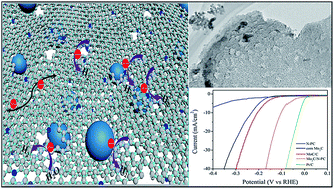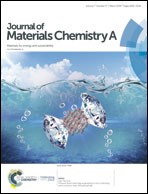Ultra-small Mo2C nanodots encapsulated in nitrogen-doped porous carbon for pH-universal hydrogen evolution: insights into the synergistic enhancement of HER activity by nitrogen doping and structural defects†
Abstract
Herein, ultra-small molybdenum carbide nanodots encapsulated in nitrogen-doped porous carbon (Mo2C/N-PC) were synthesized by a facile one-pot method. Ammonium molybdate and low-cost starch were used as precursors of Mo2C and C. Ammonium nitrate was selected as a nitrogen dopant, which played multiple roles in the reduction of MoC to Mo2C, nitrogen doping of carbon, and formation of a porous structure with abundant structural defects, thus avoiding the high-temperature reduction by H2/Ar. The optimized Mo2C/N-PC hybrid has a remarkable catalytic activity towards the HER over a wide pH range (0–14). Especially, under alkaline conditions, an overpotential as small as −100 mV vs. RHE could be achieved at 10 mA cm−2, comparable to that of the best Mo2C-based materials. The density functional theory (DFT) calculations revealed that a decreased Gibbs free energy for H* adsorption (ΔGH*) could be obtained by combining Mo2C with N-PC, proving the synergistic enhancement mechanism of nitrogen doping and structural defects. This material contains no noble metals and can be easily synthesized on a large scale; thus, it should have significant potential in hydrogen production.



 Please wait while we load your content...
Please wait while we load your content...